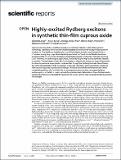Files in this item
Highly-excited Rydberg excitons in synthetic thin-film cuprous oxide
Item metadata
| dc.contributor.author | DeLange, Jacob | |
| dc.contributor.author | Barua, Kinjol | |
| dc.contributor.author | Paul, Anindya Sundar | |
| dc.contributor.author | Ohadi, Hamid | |
| dc.contributor.author | Zwiller, Val | |
| dc.contributor.author | Steinhauer, Stephan | |
| dc.contributor.author | Alaeian, Hadiseh | |
| dc.date.accessioned | 2023-10-09T16:30:01Z | |
| dc.date.available | 2023-10-09T16:30:01Z | |
| dc.date.issued | 2023-10-06 | |
| dc.identifier | 294269334 | |
| dc.identifier | 979d49c7-a959-49d2-9efd-b02d40a5ed3d | |
| dc.identifier | 85173427632 | |
| dc.identifier.citation | DeLange , J , Barua , K , Paul , A S , Ohadi , H , Zwiller , V , Steinhauer , S & Alaeian , H 2023 , ' Highly-excited Rydberg excitons in synthetic thin-film cuprous oxide ' , Scientific Reports , vol. 13 , 16881 . https://doi.org/10.1038/s41598-023-41465-y | en |
| dc.identifier.issn | 2045-2322 | |
| dc.identifier.other | Jisc: 1387075 | |
| dc.identifier.other | publisher-id: s41598-023-41465-y | |
| dc.identifier.other | manuscript: 41465 | |
| dc.identifier.other | ORCID: /0000-0001-6418-111X/work/144461300 | |
| dc.identifier.other | ORCID: /0009-0006-3652-1547/work/155069657 | |
| dc.identifier.uri | https://hdl.handle.net/10023/28518 | |
| dc.description | S.S. acknowledges support from the Swedish Research Council (Starting Grant No. 2019-04821) and from the Göran Gustafsson Foundation. H.A. acknowledges the Purdue University Startup fund, the financial support from the Industry-University Cooperative Research Center Program at the US National Science Foundation under Grant No. 2224960, and the AirForce Office of Scientific Research under award number FA9550-23-1-0489. | en |
| dc.description.abstract | Cuprous oxide (Cu2O) has recently emerged as a promising material in solid-state quantum technology, specifically for its excitonic Rydberg states characterized by large principal quantum numbers (n). The significant wavefunction size of these highly-excited states (proportional to n2) enables strong long-range dipole-dipole (proportional to n4) and van der Waals interactions (proportional to n11). Currently, the highest-lying Rydberg states are found in naturally occurring Cu2O. However, for technological applications, the ability to grow high-quality synthetic samples is essential. The fabrication of thin-film Cu2O samples is of particular interest as they hold potential for observing extreme single-photon nonlinearities through the Rydberg blockade. Nevertheless, due to the susceptibility of high-lying states to charged impurities, growing synthetic samples of sufficient quality poses a substantial challenge. This study successfully demonstrates the CMOS-compatible synthesis of a Cu2O thin film on a transparent substrate that showcases Rydberg excitons up to n=8 which is readily suitable for photonic device fabrications. These findings mark a significant advancement towards the realization of scalable and on-chip integrable Rydberg quantum technologies. | |
| dc.format.extent | 4276168 | |
| dc.language.iso | eng | |
| dc.relation.ispartof | Scientific Reports | en |
| dc.subject | DAS | en |
| dc.title | Highly-excited Rydberg excitons in synthetic thin-film cuprous oxide | en |
| dc.type | Journal article | en |
| dc.contributor.institution | University of St Andrews. School of Physics and Astronomy | en |
| dc.contributor.institution | University of St Andrews. Centre for Designer Quantum Materials | en |
| dc.identifier.doi | https://doi.org/10.1038/s41598-023-41465-y | |
| dc.description.status | Peer reviewed | en |
This item appears in the following Collection(s)
Items in the St Andrews Research Repository are protected by copyright, with all rights reserved, unless otherwise indicated.

